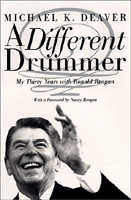 |
| ||||||||||||||||
 |
A Different Drummer: My Thirty Years with Ronald ReaganMichael K. Deaver with a Foreword by Nancy Reagan
Excerpt from A Different Drummer: My Thirty Years with Ronald Reagan Chapter One: The Early Years I stood alone in the comfortable office Ronald Reagan had used since leaving the White House. He had selected this particular office, I think, for its unforgettable view of the Pacific Ocean. This is the panorama every Southern Californian dreams of: the winding coast from Malibu to Long Beach, covered in an early-morning fog that breaks around noon most days and ends with a stunning sunset over the water. Except for his years in Sacramento and Washington, D.C., this was the view that Reagan had known and loved all his adult life. His home in Bel Air, his office at the Ronald Reagan Library in Simi Valley, the getaway at Rancho De Cielo in the Santa Barbara Hills all opened up to essentially the same scene. His and Nancy's final resting place, a tomb built for the two of them at the library, had been chosen in part because it looked across the Ventura coast to Point Mugu. The office I was standing in was all Reagan as well: the chair he used as governor, a painting behind the desk by Charles Reiffle titled Desert Below Julian, other paintings with western themes including several of his ranch and one of two of his horses, reproductions of Frederick Remington's sculptures of cowboys, Indians, and horses. There were photos of his four children, too, and of Nancy, and one of himself with Dwight Eisenhower that he has had in every office since I've known him. As I stood there, my eye fell on the little glass dome in one of the cabinets. I didn't have to move closer to know what was inside: a .22-caliber bullet inscribed “This Is It!” along with a shard of glass from the limousine Reagan had been about to climb into on that awful day in 1981 when John Hinckley had nearly ended his presidency and his life.Today was an overcast Southern California morning in 1997, about three years after Ronald Reagan had penned his open letter disclosing his Alzheimer's disease, essentially saying his farewell to the American people. The letter, simple and touching, was written by a man who never claimed to be John Keats. It tells future generations in just a few paragraphs more about the man than any Reagan biography could. As soon as Reagan finished that letter'as if on cue'the Alzheimer's seemed to worsen, deepen. He would never be the same after he put the pen down, and America would never see Citizen Reagan again. Ronald and Nancy Reagan had agreed there would be no more public appearances. The letter was his subtle yet eloquent exit from the grand stage. This would be our first meeting since the letter was written. I felt fairly certain, too, that this would be the last time I would ever see Reagan alive. It wasn't'I would see him once more'but sooner or later, and probably sooner, Nancy was going to cut off access to him altogether, even for old friends like me. She wanted him to be remembered as strong and energetic. Having spent so many years as, in effect, the cokeeper of that image, I could only sympathize. Over the course of the thirty years I had known him, I had come to love and respect Reagan like a second father. He was once asked if he thought of me as another son. He thought it over for a moment and said, “Son, no. Brother, maybe.” Joanne Drake, his chief of staff since leaving the White House, assured me that I would have to wait only a few minutes more. The president was on his way. I was actually nervous, wondering how he'd react. Would he remember me? What would I say to someone I'd worked side by side with for all those years? Someone whom I have seen at his highest heights and lowest depths? What do you say to a man who, thanks to Alzheimer's, you know more about than he does? There were a number of framed pictures on the shelves, which served as personal reminders for a man with a fading memory. Joanne had told me they helped him link newly designated strangers like me with the past. Reagan had developed a routine he was very comfortable with when greeting visitors. He would walk them around the office, talking about specific photos or other objects so he could gauge the visitor's interest in each and begin to connect his visitor with his past. I could envision the drill. And I understood the gimmick: It was vintage Reagan. Take the focus off him and toss it casually upon your shoulders. With Reagan, it was never about himself. The photos and mementos came in handy, as there were many like me who came calling, seeking just one more moment of camaraderie and friendship. That was my sole reason for being here this day. I was in Los Angeles and I wanted to see my old friend again. The sound of stirrings in the outside office snapped me out of my reverie. Through the open door came Ronald Reagan. The man I called governor and Mr. President'only once would I call him Ron'was back in my life. A crooked smile creased his face as he extended his hand and took mine. I felt that old infectious joy and optimism he always seemed to carry into a room. His chestnut hair had given up the battle against time and was brushed with a dignified gray. I know for certain that no dye ever touched Reagan's hair. For years, the Reagan haters had literally sifted through his barber's trash can, searching for a dyed gray lock that could serve as a tiny metaphor for a phony man and an even more phony presidency. They searched in vain. It was an old actor's trick -- Brylcreem -- that gave Reagen's hair that dark gloss, not Clairol for Men. His shoulders were a little stooped on this day, and his movements were slower than I had remembered. He looked docile and a bit worn. The man who had brought the Soviet bear to its knees now seemed more like a gentleman you might see in a Leisure World lobby, not the West Wing. Still, the look was the same. A crisp white shirt, a flawless dark suit with a half inch of cuff showing at the wrist. We made small talk for a few minutes before Reagan escorted me toward the pictures that documented his life, but I don't think he gleaned any clues of who I was based on my reactions. Undaunted, he fixed his eyes on the now-famous photo of himself as a young lifeguard at Rock River. He pointed to the hulking image with pride, asking if I had any idea how many lives he had saved during the time he kept watch there. Without hesitation, I belted out the precise number, “Seventy-seven.” —From A Different Drummer: My Thirty Years with Ronald Reagan, by Michael K. Deaver, Nancy Reagan. © April 20, 2001 , HarperCollins used by permission. Find Items On Similar Subjects |
|||||||||||||||||||||
|
All prices subject to change and given in U.S. Dollars. |
All materials contained in http://www.LeadershipNow.com are protected by copyright and trademark laws and may not be used for any purpose whatsoever other than private, non-commercial viewing purposes. Derivative works and other unauthorized copying or use of stills, video footage, text or graphics is expressly prohibited. LeadershipNow is a trademark of M2 Communications, LLC. |
